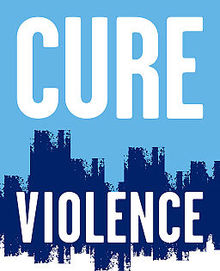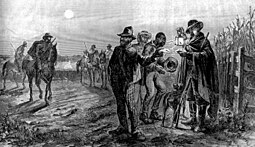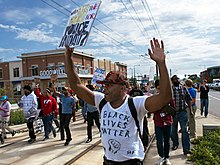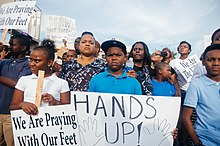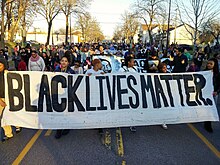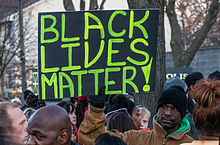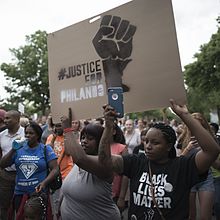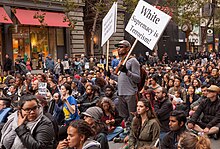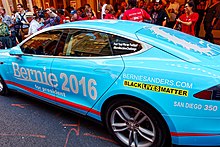From Wikipedia, the free encyclopedia
Black Lives Matter
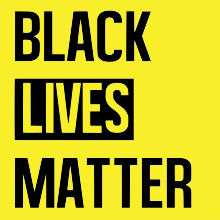 |
| Formation | July 13, 2013 |
|---|
| Founders |
|
|---|
| Type | Activist organization |
|---|
| Purpose | Anti-racist advocacy and protest |
|---|
| Location |
- International
(mostly in the United States)
|
|---|
Key people
|
|
|---|
| Website | blacklivesmatter.com |
|---|
In 2013, the movement began with the use of the
hashtag #BlackLivesMatter on
social media after
the acquittal of
George Zimmerman in
the shooting death of African-American teen
Trayvon Martin
in February 2012. The movement became nationally recognized for street
demonstrations following the 2014 deaths of two African Americans:
Michael Brown—resulting in
protests and unrest in Ferguson, a city near
St. Louis—and
Eric Garner in New York City.
Since the Ferguson protests, participants in the movement have
demonstrated against the deaths of numerous other African Americans by
police actions and/or while in police custody. In the summer of 2015,
Black Lives Matter activists became involved in the
2016 United States presidential election. The originators of the hashtag and call to action,
Alicia Garza,
Patrisse Cullors, and
Opal Tometi, expanded their project into a national network of over 30 local chapters between 2014 and 2016. The overall Black Lives Matter movement, however, is a decentralized network and has no formal hierarchy.
The movement returned to national headlines and gained further international attention during the global
George Floyd protests in 2020 following Floyd's death by
police in Minneapolis, Minnesota.
Founding
Earlier movements
BLM claims inspiration from the
civil rights movement, the
Black Power movement, the 1980s
Black feminist movement,
pan-Africanism, the
Anti-Apartheid Movement,
hip hop,
LGBTQ social movements, and
Occupy Wall Street. Several media organizations have referred to BLM as "a new civil rights movement." Some of the protesters, however, actively distinguish themselves from the older generation of black leadership, such as
Al Sharpton, by their aversion to middle-class traditions such as
church involvement,
Democratic Party loyalty, and
respectability politics. Political scientist Frederick C. Harris has argued that this "group-centered model of leadership" is distinct from the older
charismatic leadership model that characterized civil rights organizations like
Jesse Jackson's
Rainbow PUSH Coalition and Sharpton's
National Action Network.
Online campaign
"Million Hoodie March" in
Union Square, Manhattan on March 21, 2012, protesting George Zimmerman's shooting of Trayvon Martin
In the summer of 2013, after
George Zimmerman's
acquittal for
the shooting death of
Trayvon Martin, the movement began with the hashtag #BlackLivesMatter. The movement was co-founded by three black
community organizers:
Alicia Garza,
Patrisse Cullors, and
Opal Tometi.
Garza, Cullors and Tometi met through "Black Organizing for Leadership
& Dignity" (BOLD), a national organization that trains
community organizers.
They began to question how they were going to respond to what they saw
as the devaluation of black lives after Zimmerman's acquittal. Garza
wrote a Facebook post titled "A Love Note to Black People" in which she
said: "Our Lives Matter, Black Lives Matter". Cullors replied:
"#BlackLivesMatter". Tometi then added her support, and Black Lives
Matter was born as an
online campaign.
Ferguson activism
Protests in Ferguson, Missouri, August 17, 2014
In August 2014, BLM members organized their first in-person national protest in the form of a "Black Lives Matter
Freedom Ride" to
Ferguson, Missouri after the
shooting of Michael Brown.
More than five hundred members descended upon Ferguson to participate
in non-violent demonstrations. Of the many groups that descended on
Ferguson, Black Lives Matter emerged from Ferguson as one of the best
organized and most visible groups, becoming nationally recognized as
symbolic of the emerging movement.
The activities in the streets of Ferguson caught the attention of
a number of Palestinians who tweeted advice on how to deal with tear
gas.
This connection helped to bring to Black activists' attention the ties
between the Israeli armed forces and police in the United States, and later influenced the Israel section of the platform of the Movement for Black Lives, released in 2016.
Since then, Black Lives Matter has organized thousands of
protests and demonstrations. Expanding beyond street protests, BLM has
expanded to activism on American college campuses, such as the
2015–16 University of Missouri protests.
Inclusivity of the movement
Black Lives Matter incorporates those traditionally on the margins of black freedom movements. The organization's website, for instance, states that Black Lives Matter is "a unique contribution that goes beyond
extrajudicial killings of Black people by police and vigilantes" and, embracing
intersectionality, that "Black Lives Matter affirms the lives of
Black queer and trans folks, disabled folks, black-
undocumented folks,
folks with records,
women, and all Black lives along the gender spectrum." All three founders of the Black Lives Matter movement are women, and Garza and Cullors identify as queer. Additionally,
Elle Hearns, one of the founding organizers of the global network, is a
transgender woman. The founders believe that their backgrounds have paved the way for Black Lives Matter to be an
intersectional
movement. Several hashtags such as #BlackWomenMatter,
#BlackGirlsMatter, #BlackQueerLivesMatter, and #BlackTransLivesMatter
have surfaced on the BLM website and throughout social media networks.
Marcia Chatelain, associate professor of history at
Georgetown University, has praised BLM for allowing "young, queer women [to] play a central role" in the movement.
Black Lives Matter supporters and allies gather inside the
Minneapolis City Hall
rotunda on December 3, 2015, after an early morning raid and eviction
of demonstrators occupying the space outside the Minneapolis Police
Department's 4th Precinct, following the police shooting death of Jamar
Clark.
Structure and organization
Loose structure
The phrase "Black Lives Matter" can refer to a
Twitter hashtag, a
slogan, a
social movement,
or a loose confederation of groups advocating for racial justice. As a
movement, Black Lives Matter is decentralized, and leaders have
emphasized the importance of local organizing over national leadership. Activist
DeRay McKesson
has commented that the movement "encompasses all who publicly declare
that black lives matter and devote their time and energy accordingly."
In 2013, Patrisse Cullors, Alicia Garza, and Opal Tometi formed
the Black Lives Matter Network. Alicia Garza described the network as an
online platform that existed to provide activists with a shared set of
principles and goals. Local Black Lives Matter chapters are asked to
commit to the organization's list of guiding principles, but operate
without a central structure or hierarchy. Alicia Garza has commented
that the Network was not interested in "policing who is and who is not
part of the movement." Currently, there are approximately 16 Black Lives Matter chapters in the U.S. and Canada.
Notable Black Lives Matter activists include co-founder of the Seattle Black Lives Matter chapter
Marissa Johnson, lawyer and president of the Minneapolis chapter of the
NAACP Nekima Levy-Pounds, and writer
Shaun King. In a September 2016 interview with
W. Kamau Bell and
Hari Kondabolu,
King described himself as part of the broader Black Lives Matter
movement and supportive of the formal organization Black Lives Matter,
but not affiliated with the latter.
The loose structure of Black Lives Matter has contributed to
confusion in the press and among activists, as actions or statements
from chapters or individuals are sometimes attributed to "Black Lives
Matter" as a whole.
Matt Pearce, writing for the
Los Angeles Times,
commented that "the words could be serving as a political rallying cry
or referring to the activist organization. Or it could be the fuzzily
applied label used to describe a wide range of protests and
conversations focused on racial inequality."
Guiding principles
Broader movement
Concurrently, a broader movement involving several other
organizations and activists emerged under the banner of "Black Lives
Matter" as well. For example, BLM is a member organization of the
Movement for Black Lives established to respond to sustained and increasingly visible violence against black communities in the U.S. and globally. In 2015
Johnetta Elzie,
DeRay Mckesson,
Brittany Packnett, and
Samuel Sinyangwe, initiated
Campaign Zero,
aimed at promoting policy reforms to end police brutality. The campaign
released a ten-point plan for reforms to policing, with recommendations
including: ending
broken windows policing, increasing community oversight of police departments, and creating stricter guidelines for the use of force.
New York Times
reporter John Eligon reported that some activists had expressed
concerns that the campaign was overly focused on legislative remedies
for police violence.
Policy demands
In 2016, Black Lives Matter and a coalition of 60 organizations affiliated with BLM called for
decarceration in the United States,
reparations for slavery in the United States, an end to mass
surveillance, investment in public education, not incarceration, and
community control of the police: empowering residents in communities of
color to hire and fire police officers and issue subpoenas, decide
disciplinary consequences and exercise control over city funding of
police.
Strategies and tactics
Black Lives Matter originally used various social media platforms—including
hashtag activism—to reach thousands of people rapidly. Since then, Black Lives Matters has embraced a
diversity of tactics.
Internet and social media
By September 2016, the phrase "Black Lives Matter" had been tweeted over 30 million times, and
Black Twitter has
been credited with bringing international attention to the BLM
movement. Using the hashtag #BlackLivesMatter has helped activists
communicate the scale of their movement to the wider online community
and stand in solidarity amongst other participants.
Dr. Khadijah White, a professor at
Rutgers University, argues that BLM has ushered in a new era of black university student movements. The ease with which
bystanders can record graphic videos of police violence and post them onto social media has driven activism all over the world.
Direct action
Black Lives Matter demonstration in Oakland, California
BLM generally engages in
direct action tactics that make people uncomfortable enough that they must address the issue. BLM has been known to build power through protest and rallies. BLM has also staged
die-ins and held one during the 2015
Twin Cities Marathon.
"
Hands up!" sign displayed at a Ferguson protest
According to a 2018 study, "Black Lives Matter protests are more
likely to occur in localities where more Black people have previously
been killed by police."
Media
Reaction
There have been many reactions to the Black Lives Matter movement.
The U.S. population's perception of Black Lives Matter varies
considerably by race. The phrase "
All Lives Matter"
sprang up as a response to the Black Lives Matter movement, but has
been criticized for dismissing or misunderstanding the message of "Black
Lives Matter". Following the shooting of two police officers in Ferguson, the hashtag
Blue Lives Matter was created by supporters of the police. Some civil rights leaders have disagreed with tactics used by Black Lives Matter activists.
Funding
Black Lives Matter have received over $100 million in funding from the
Open Society Foundations,
Ford Foundation and Borealis Philanthropy among others.
In addition, the Black Lives Matter Movement has received support from
organizations and foundations like the Black Youth Project 100, the
Black Civic Engagement Fund, the Center for Popular Democracy, Color of
Change and the Advancement Project.
Timeline of notable US events and demonstrations
2014
In 2014, Black Lives Matter demonstrated against the deaths of numerous African Americans by police actions, including those of
Dontre Hamilton,
Eric Garner,
John Crawford III,
Michael Brown,
Ezell Ford,
Laquan McDonald,
Akai Gurley,
Tamir Rice,
Antonio Martin, and
Jerame Reid, among others.
In July,
Eric Garner died in New York City, after a
New York City Police Department officer put him in a banned
chokehold
while arresting him. Garner's death has been cited as one of several
police killings of African Americans that sparked the Black Lives Matter
movement.
In August, during Labor Day weekend, Black Lives Matter organized
a "Freedom Ride", that brought more than 500 African-Americans from
across the United States into
Ferguson, Missouri, to support the work being done on the ground by local organizations. The movement continued to be involved in the
Ferguson unrest, following the death of Michael Brown. Also in August,
Los Angeles Police Department officers shot and killed
Ezell Ford. Following the shooting, BLM protested his death in Los Angeles into 2015.
In November, a
New York City Police Department officer shot and killed,
Akai Gurley, a 28-year-old African-American man. Gurley's death was later protested by Black Lives Matter in New York City. In
Oakland, California, fourteen Black Lives Matter activists were arrested after they stopped a
Bay Area Rapid Transit (BART) train for more than an hour on
Black Friday, one of the biggest shopping days of the year. The protest, led by Black Lives Matter co-founder
Alicia Garza, was organized in response to the grand jury decision not to indict Darren Wilson for the death of Mike Brown.
Also in November,
Tamir Rice,
a 12-year-old African-American boy was shot and killed by a Cleveland
police officer. Rice's death has also been cited as contributing to
"sparking" the Black Lives Matter movement.
Also in December, in response to the decision by the grand jury
not to indict Darren Wilson on any charges related to the death of
Michael Brown, a protest march was held in
Berkeley,
California. Later, in 2015, protesters and journalists who participated
in that rally filed a lawsuit alleging "unconstitutional police
attacks" on attendees.
2015
A demonstrator, wearing the uniform of the Orioles baseball team on the street in Baltimore
In 2015, Black Lives Matter demonstrated against the deaths of numerous African Americans by police actions, including those of
Charley Leundeu Keunang,
Tony Robinson,
Anthony Hill,
Meagan Hockaday,
Eric Harris,
Walter Scott,
Freddie Gray,
William Chapman,
Jonathan Sanders,
Sandra Bland,
Samuel DuBose,
Jeremy McDole,
Corey Jones, and
Jamar Clark as well Dylan Roof's murder of
The Charleston Nine.
In May, a protest by BLM in San Francisco was part of a nationwide protest,
Say Her Name, decrying the police killing of black women and girls, which included the deaths of
Meagan Hockaday,
Aiyana Jones,
Rekia Boyd, and others. In
Cleveland, Ohio, after an officer was acquitted at trial in the
shooting of Timothy Russell and Malissa Williams, BLM protested. In
Madison, Wisconsin, BLM protested after the officer was not charged in the
shooting of Tony Robinson.
Black Lives Matter protest against St. Paul police brutality at
Metro Green Line
In July, BLM activists across the United States began protests over the
death of Sandra Bland, an African-American woman, who was allegedly found hanged in a jail cell in
Waller County, Texas. In
Cincinnati, Ohio, BLM rallied and protested the
death of Samuel DuBose after he was shot and killed by a
University of Cincinnati police officer. In
Newark, New Jersey, over a thousand BLM activists marched against police brutality, racial injustice, and economic inequality. Also in July, BLM protested the
death of Jonathan Sanders who died while being arrested by police in Mississippi.
In August, BLM organizers held a rally in
Washington, D.C., calling for a stop to violence against
transgender women. In
Charlotte, North Carolina, after a judge declared a
mistrial in the trial of a white Charlotte police officer who killed an unarmed black man,
Jonathan Ferrell, BLM protested and staged
die-ins. In
Philadelphia,
Pennsylvania,
Janelle Monáe,
Jidenna, and other BLM activists marched through
North Philadelphia to bring awareness to police brutality and Black Lives Matter. Around August 9, the first anniversary of
Michael Brown's death, BLM rallied, held vigil and marched in
St. Louis and across the country.
In October, Black Lives Matters activists were arrested during a protest of a police chiefs conference in Chicago. "Rise Up October" straddled the Black Lives Matter Campaign, and brought several protests.
Quentin Tarantino and
Cornel West, participating in "Rise Up October", decried police violence.
An
activist holds a "Black Lives Matter" sign outside the Minneapolis
Police Fourth Precinct building following the officer-involved shooting
of Jamar Clark on November 15, 2015.
In November, BLM activists protested after
Jamar Clark was shot by
Minneapolis Police Department.
A continuous protest was organized at the Minneapolis 4th Precinct
Police. During the encamped protest, protestors, and outside agitators
clashed with police, vandalized the station and attempted to ram the
station with an SUV.
Later that month a march was organized to honor Jamar Clark, from the
4th Precinct to downtown Minneapolis. After the march, a group of men
carrying firearms and body armor
appeared and began calling the protesters racial slurs according to a
spokesperson for Black Lives Matter. After protesters asked the armed
men to leave, the men opened fire, shooting five protesters.
All injuries required hospitalization, but were not life-threatening.
The men fled the scene only to be found later and arrested. The three
men arrested were young and white, and observers called them
white supremacists.
In February 2017, one of the men arrested, Allen Scarsella, was
convicted of a dozen felony counts of assault and riot in connection
with the shooting. Based in part on months of racist messages Scarsella
had sent his friends before the shooting, the judge rejected arguments
by his defense that Scarsella was "naïve" and sentenced him in April
2017 to 15 years out of a maximum 20-year sentence.
From November into 2016, BLM protested the
shooting death of Laquan McDonald,
calling for the resignation of numerous Chicago officials in the wake
of the shooting and its handling. McDonald was shot 16 times by Chicago
Police Officer Jason Van Dyke.
2016
In 2016, Black Lives Matter demonstrated against the deaths of
numerous African Americans by police actions, including those of Bruce
Kelley Jr.,
Alton Sterling,
Philando Castile,
Joseph Mann,
Abdirahman Abdi,
Paul O'Neal,
Korryn Gaines,
Sylville Smith,
Terence Crutcher,
Keith Lamont Scott,
Alfred Olango, and
Deborah Danner, among others.
In January, hundreds of BLM protesters marched in
San Francisco to protest the December 2, 2015, shooting death of Mario Woods, who was shot by
San Francisco Police officers. The march was held during a
Super Bowl event.
BLM held protests, community meetings, teach-ins, and direct actions
across the country with the goal of "reclaim[ing] the radical legacy of
Martin Luther King Jr."
In February,
Abdullahi Omar Mohamed, a 17-year-old Somali refugee, was shot and injured by
Salt Lake City,
Utah, police after allegedly being involved in a confrontation with another person. The shooting led to BLM protests.
In June, members of BLM and
Color of Change
protested the California conviction and sentencing of Jasmine Richards
for a 2015 incident in which she attempted to stop a police officer from
arresting another woman. Richards was convicted of "attempting to
unlawfully take a person from the lawful custody of a peace officer", a
charge that the state penal code had designated as "
lynching" until that word was removed two months prior to the incident.
On July 5,
Alton Sterling,
a 37-year-old black man, was shot several times at point-blank range
while pinned to the ground by two white Baton Rouge Police Department
officers in
Baton Rouge,
Louisiana. On the night of July 5, more than 100 demonstrators in Baton
Rouge shouted "no justice, no peace," set off fireworks, and blocked an
intersection to protest Sterling's death. On July 6, Black Lives Matter held a
candlelight vigil in Baton Rouge, with chants of "We love Baton Rouge" and calls for justice.
On July 6,
Philando Castile was fatally shot by Jeronimo Yanez, a
St. Anthony, Minnesota police officer, after being pulled over in
Falcon Heights, a suburb of
St. Paul.
Castile was driving a car with his girlfriend and her 4-year-old
daughter as passengers when he was pulled over by Yanez and another
officer. According to his girlfriend, after being asked for his license and registration, Castile told the officer he was licensed to
carry a weapon and had one in the car.
She stated: "The officer said don't move. As he was putting his hands
back up, the officer shot him in the arm four or five times." She
live-streamed a video on
Facebook
in the immediate aftermath of the shooting. Following the fatal
shooting of Castile, BLM protested throughout Minnesota and the United
States.
On July 7, a BLM protest was held in
Dallas, Texas that was organized to protest the deaths of
Alton Sterling and
Philando Castile. At the end of the peaceful protest, Micah Xavier Johnson
opened fire in an ambush,
killing five police officers and wounding seven others and two
civilians. The gunman was then killed by a robot-delivered bomb.
Before he died, according to police, Johnson said that "he was upset
about Black Lives Matter", and that "he wanted to kill white people,
especially white officers." Texas Lt. Governor
Dan Patrick and other conservative lawmakers blamed the shootings on the Black Lives Matter movement. The Black Lives Matter network released a statement denouncing the shootings. On July 8, more than 100 people were arrested at Black Lives Matter protests across the United States.
In the first half of July, there were at least 112 protests in 88 American cities. In July 2016,
NBA stars
LeBron James,
Carmelo Anthony,
Chris Paul, and
Dwyane Wade opened the
2016 ESPY Awards with a Black Lives Matter message. On July 26, Black Lives Matter held a protest in
Austin, Texas, to mark the third anniversary of the shooting death of
Larry Jackson Jr. On July 28,
Chicago Police Department officers
shot Paul O'Neal in the back and killed him following a car chase. After the shooting, hundred marched in
Chicago, Illinois.
In August, in
Pittsburgh,
Pennsylvania, Black Lives Matter protested the death of Bruce Kelley
Jr. who was shot after fatally stabbing a police dog while trying to
escape from police the previous January.
Beginning in August, several professional athletes have participated in the
2016 U.S. national anthem protests. The protests began in the
National Football League (NFL) after
Colin Kaepernick of the
San Francisco 49ers sat during the anthem, as opposed to the tradition of standing, before his team's third
preseason game of 2016.
During a post-game interview he explained his position stating, "I am
not going to stand up to show pride in a flag for a country that
oppresses black people and
people of color.
To me, this is bigger than football and it would be selfish on my part
to look the other way. There are bodies in the street and people getting
paid leave and getting away with murder," a protest widely interpreted as in solidarity with the Black Lives Matter movement. The protests have generated mixed reactions, and have since spread to other U.S. sports leagues.
In September 2016, BLM protested the shooting deaths by police officers of
Terence Crutcher in
Tulsa, Oklahoma, and
Keith Lamont Scott in
Charlotte, North Carolina.
The Charlotte Observer
reported "The protesters began to gather as night fell, hours after the
shooting. They held signs that said 'Stop Killing Us' and 'Black Lives
Matter,' and they chanted 'No justice, no peace.' The scene was
sometimes chaotic and tense, with water bottles and stones chucked at
police lines, but many protesters called for peace and implored their
fellow demonstrators not to act violently." Multiple nights of protests from September to October 2016 were held in
El Cajon, California, following the
shooting of Alfred Olango.
2017
March against the Yanez not guilty verdict in the shooting of
Philando Castile on June 18, 2017
In 2017, in
Black History Month, a month-long "Black Lives Matter" art exhibition was organized by three
Richmond,
Virginia artists at the First Unitarian Universalist Church of Richmond
in the Byrd Park area of the city. The show featured more than 30
diverse multicultural artists on a theme exploring racial equality and
justice.
In the same month
Virginia Commonwealth University's James Branch Cabell Library focused on a month-long schedule of events relating to
Black history and showed photos from the church's "Black Lives Matter" exhibition on its outdoor screen. The
VCU schedule of events also included: the Real Life Film Series
The Angry Heart: The Impact of Racism on Heart Disease among African-Americans;
Keith Knight presented the 14th Annual VCU Libraries Black History Month lecture;
Lawrence Ross, author of the book
Blackballed: The Black and White Politics of Race on America's Campuses talked about how his book related to the "Black Lives Matter" movement; and
Velma P. Scantlebury,
M.D., the first black female transplant surgeon in the United States,
discussed "Health Equity in Kidney Transplantation: Experiences from a
surgeon's perspective."
On September 27, 2017, at the
College of William & Mary, students associated with Black Lives Matter protested an
ACLU event because the ACLU had fought for the right of
Unite the Right rally to be held in Charlottesville, Virginia. William & Mary's president
Taylor Reveley responded with a statement defending the college's commitment to open debate.
2018
In February and March, as part of its social justice focus,
First Unitarian Universalist Church in Richmond, Virginia presented its
Second Annual Black Lives Matter Art Exhibition. Works of art in the exhibition were projected at scheduled hours on the large exterior screen (jumbotron) at
Virginia Commonwealth University's
Cabell Library. Artists with art in the exhibition were invited to
discuss their work in the Black Lives Matter show as it was projected at
an evening forum in a small amphitheater at VCU's Hibbs Hall. They were
also invited to exhibit afterward at a local showing of the film
A Raisin in the Sun.
In April 2018, CNN reported that the largest Facebook account
claiming to be a part of the "Black Lives Matter" movement was a "scam"
tied to a white man in Australia. The account, with 700,000 followers,
linked to fundraisers that raised $100,000 or more, purportedly for U.S.
Black Lives Matter causes; however, some of the money was instead
transferred to Australian banks accounts, according to CNN. Facebook has
suspended the offending page.
2020
On February 23, Ahmaud Arbery, an unarmed 25-year-old
African-American man, was fatally shot while jogging in
Glynn County, Georgia. Arbery had been pursued and confronted by two
white residents, a father and son, who were armed and driving a pickup truck.
On March 13, Louisville police officers knocked down the
apartment door of 26 year old African American Breonna Taylor, serving a
no-knock search warrant for drug suspicions.
Police fired several shots during the encounter which led to her death. Her boyfriend who was present at the time had called 911 and said, "someone kicked in the door and shot my girlfriend".
On May 25, Christian Cooper, a black bird watcher at New York's
Central Park experienced a confrontation with a white woman after he
asked her to put her dog on a leash in
the Ramble,
a no-dogs-off-leash area. The interaction escalated when the white
woman called the police to say that an African American man was
threatening her.
George Floyd protests
May 30, 2020. Lafayette Square, Washington D.C. George Floyd protest.
At the end of May, spurred on by a rash of racially charged events including those above, over 450
major protests were held in cities and towns across the United States and three continents. The breaking point was due primarily to
the police killing of George Floyd by Minneapolis police officer
Derek Chauvin,
eventually charged with second degree murder after a video circulated
showing Chauvin kneeling on Floyd's neck for nearly nine minutes while
Floyd pleaded for his life, repeating, "
I can't breathe."
Following protesters' demands for additional prosecutions, three other
officers were charged with aiding and abetting second degree murder.
Protests in May, 2020, after George Floyd's death
Black Lives Matter organized rallies in the United States and worldwide from May 30 onwards, with protesters enacting Floyd's final moments, many lying down in
streets and on bridges, yelling "I can't breathe," while others marched
by the thousands, some carrying signs that read, "Tell your brother in
blue, don't shoot"--"Who do you call when the murderer wears a badge?"
and "Justice for George Floyd."
While global in nature and supported by a number of unassociated
organizations, Black Lives Matter movement has been inextricably linked
to these monumental protests. Black Lives Matter called to "
Defund the Police," a slogan with varying interpretations from
police abolition to divestment from police and prisons to reinvestment in social services in communities of color.
On June 7, 2020, in the wake of global
George Floyd protests and Black Lives Matter's call to "Defund the Police," the
Minneapolis City Council
voted to "disband its police department" to shift funding to social
programs in communities of color. City Council President Lisa Bender
said, "Our efforts at incremental reform have failed. Period." The
council vote came after the Minneapolis Public Schools, the University
of Minnesota and Minneapolis Parks and Recreation cut ties with the
Minneapolis Police Department.
BLM international movement
Black Lives Matter protest at Union Square, Manhattan
Black Lives Matter protest in
Berlin, Germany, May 30, 2020
In 2015, after the
death of Freddie Gray in
Baltimore, Maryland, black activists around the world modeled efforts for reform on Black Lives Matter and the
Arab Spring. This international movement has been referred to as the "Black Spring". Connections have also been forged with parallel international efforts such as the
Dalit rights movement.
Australia
Following the
death of Ms Dhu in police custody in August 2014, protests often made reference to the BLM movement. In July 2016, a BLM rally was organized in
Melbourne, Australia, which 3,500 people attended. The protest also emphasized the issues of mistreatment of
Aboriginal Australians by the Australian police and government.
In May 2017, Black Lives Matter was awarded the
Sydney Peace Prize, which "honours a nominee who has promoted 'peace with justice', human rights and non-violence".
Canada
In July 2015, BLM protesters shut down
Allen Road
in Toronto, Ontario, protesting the shooting deaths of two black men in
the metropolitan area—Andrew Loku and Jermaine Carby—at the hands of
police.
In September, BLM activists shut down streets in Toronto, rallied
against police brutality, and stood in solidarity with marginalized
black lives. Black Lives Matter was a featured part of the
Take Back the Night event in Toronto.
In June 2016, Black Lives Matter was selected by
Pride Toronto as the honoured group in that year's Pride parade, during which they staged a
sit-in to block the parade from moving forward for approximately half an hour. They issued a number of demands for Pride to adjust its relationship with
LGBTQ people of colour, including stable funding and a suitable venue for the established
Blockorama event, improved diversity in the organization's staff and volunteer base, and that
Toronto Police officers be banned from marching in the parade in uniform. Pride executive director
Mathieu Chantelois
signed BLM's statement of demand, but later asserted that he had signed
it only to end the sit-in and get the parade moving, and had not agreed
to honour the demands.
New Zealand
On June 1, 2020, several BLM
solidarity protests in response to the
death of
George Floyd were held in several New Zealand cities including
Auckland,
Wellington,
Christchurch,
Dunedin,
Tauranga,
Palmerston North and
Hamilton.
The Auckland event, which attracted between 2,000 and 4,000
participants, was organised by several members of New Zealand's African
community. Auckland organiser Mahlete Tekeste, African-American
expatriate Kainee Simone, and sportsperson
Israel Adesanya compared racism, mass incarceration, and police violence against African Americans to the over-representation of
Māori and
Pacific Islanders
in New Zealand prisons, the controversial armed police response squad
trials, and existing racism against minorities in New Zealand including
the 2019
Christchurch mosque shootings. Hip hop artist and music producer Mazbou Q also called on
Prime Minister Jacinda Ardern to condemn violence against Black Americans.
The left-wing
Green Party, a member of the
Labour-led coalition government,
has also expressed support for the Black Lives Matter movement, linking
the plight of African Americans to the racism, inequality, and higher
incarceration rate experienced by the Māori and Pasifika communities.
The BLM protests in New Zealand attracted criticism from
Deputy Prime Minister Winston Peters for violating the country's
COVID-19 pandemic social distancing regulations banning mass gatherings of over 100 people.
United Kingdom
On August 4, 2016, BLM protesters blocked
London Heathrow Airport in
London, England. Several demonstrators chained themselves together and lay against the motorway leading to the airport.
Ten people were arrested in connection with the incident. There were
also BLM-themed protests in other English cities including
Birmingham and
Nottingham. The UK-held protests marked the fifth anniversary of the shooting
death of Mark Duggan.
Black Lives Matter UK held protests in 2020 in support of the
Black Lives Matter protests in the USA. London protests took place in
Trafalgar Square on May 31,
Hyde Park on June 3,
Parliament Square on June 6, and outside the US Embassy on June 7. Similar protests took place in
Manchester, Bristol,
Leeds and
Cardiff.
The UK protests not only showed solidarity with USA protestors, they
also commemorated black people who have died in the UK, with protestors
chanting, carrying signs, and sharing social media posts with names of
victims including Julian Cole, Belly Mujinga, Nuno Cardoso, Sarah Reed, and more.
On 7 June 2020 protests continued in many towns and cities. During a Black Lives Matter protest in
Bristol, the city centre
statue of Edward Colston,
a philanthropist, politician and slave trader, was pulled down by
protestors, rolled along the road and pushed into Bristol Harbour. The act was later condemned by
Home Secretary Priti Patel who said "This hooliganism is utterly indefensible."
In
London, after it was defaced a few days earlier, protestors defaced the
statue of Winston Churchill, Parliament Square,
Westminster
with graffiti for a second time. Black spray paint was sprayed over his
name and the words "was a racist" were sprayed underneath. A protestor also attempted to burn the
Union Jack Flag flying at the Cenotaph, a memorial to Britain’s war dead.
Later in the evening violence broke out between protestors and Police. A
total of 49 Police Officers were injured after demonstrators threw
bottles and fireworks at them.
Over the weekend, a total of 135 arrests were made by Police. British Prime Minister
Boris Johnson
commented on the events saying "those who attack public property or the
police – who injure the police officers who are trying to keep us all
safe – those people will face the full force of the law; not just
because of the hurt and damage they are causing, but because of the
damage they are doing to the cause they claim to represent.
Germany
On June 6, 2020, tens of thousands of people have gathered across Germany to support the Black Lives Matter movement.
2016 U.S. presidential election
Bern Machine with a BLM sticker, September 18, 2015
Primaries
Democrats
At the
Netroots Nation Conference in July 2015, dozens of Black Lives Matter activists took over the stage at an event featuring
Martin O'Malley
and Bernie Sanders. Activists, including Black Lives Matter co-founder
Patrisse Cullors, asked both candidates for specific policy proposals to
address deaths in police custody.
The protesters chanted several slogans, including "if I die in police
custody, burn everything down". After conference organizers pleaded with
the protesters for several minutes, O'Malley responded by pledging to
release a wide-ranging plan for criminal justice reform. Protesters
later booed O'Malley when he stated "Black lives matter. White lives
matter. All lives matter." O'Malley later apologized for his remarks, saying that he did not mean to disrespect the black community.
On August 8, 2015, a speech by
Democratic presidential candidate and civil rights activist
Bernie Sanders was disrupted by a group who would go on to found the Seattle Chapter of Black Lives Matter including chapter co-founder
Marissa Johnson who walked onstage, seized the microphone from him and called his supporters racists and white supremacists. Sanders issued a platform in response.
Nikki Stephens, the operator of a Facebook page called "Black Lives
Matter: Seattle" issued an apology to Sanders' supporters, claiming
these actions did not represent her understanding of BLM. She was then
sent messages by members of the Seattle Chapter which she described as
threatening, and was forced to change the name of her group to "Black in
Seattle". The founders of Black Lives Matter stated that they had not
issued an apology.
In August 2015, the
Democratic National Committee passed a resolution supporting Black Lives Matter.
In the first Democratic primary debate, the presidential candidates were asked whether black lives matter or all lives matter. In reply, Bernie Sanders stated, "Black lives matter."
Martin O'Malley said, "Black lives matter," and that the "movement is
making is a very, very legitimate and serious point, and that is that as
a nation we have undervalued the lives of black lives, people of
color." In response, Hillary Clinton pushed for criminal justice reform, and said, "We need a new New Deal for communities of color."
Jim Webb, on the other hand, replied: "As the president of the United States, every life in this country matters."
Hillary Clinton
was not directly asked the same question, but was instead asked: "What
would you do for African Americans in this country that President Obama
couldn't?"
Clinton had already met with Black Lives Matter representatives, and
emphasized what she described as a more pragmatic approach to enacting
change, stating "Look, I don't believe you change hearts. I believe you
change laws". Without policy change, she felt "we'll be back here in 10
years having the same conversation."
In June 2015, Clinton used the phrase "all lives matter" in a speech
about the opportunities of young people of color, prompting backlash
that she may misunderstand the message of "Black Lives Matter."
A week after the first Democratic primary debate was held in Las
Vegas, BLM launched a petition targeted at the DNC and its chairwoman
Debbie Wasserman Schultz demanding more debates, and "specifically for a #BlackLivesMatter themed Presidential debate." The petition received over 10,000 signatures within 24 hours of being launched, and had over 33,000 signatures as of October 27, 2015.
The DNC said that it would permit presidential candidates to attend a
presidential town hall organized by activists, but that it would not add
another debate to its official schedule.
In response, the organization released a press statement on its
Facebook page stating that "[i]n consultation with our chapters, our
communities, allies, and supporters, we remain unequivocal that a
Presidential Town Hall with support from the DNC does not sufficiently
respond to the concerns raised by our members", continuing to demand a
full additional debate.
After the first debate, in October 2015, a speech by Hillary Clinton on criminal justice reform and race at
Atlanta University Center was interrupted by BLM activists.
In February 2016, two Black Lives Matters activists protested at a
private fundraiser for Clinton about statements she made in 1996 in
which she referred to young people as "super-predators". One of the
activists wanted Clinton to apologize for "mass incarceration" in
connection with her support for her husband, then-President Bill
Clinton's
1994 criminal reform law.
Republicans
Republican candidates have been mostly critical of BLM. In August 2015,
Ben Carson, the only African American vying for the Republican nomination for the presidency, called the movement "silly". Carson also said that BLM should care for all black lives, not just a few. In the first Republican presidential debate, which took place in Cleveland, one question referenced Black Lives Matter. In response to the question,
Scott Walker advocated for the proper training of law enforcement
[263] and blamed the movement for rising anti-police sentiment, while
Marco Rubio was the first candidate to publicly sympathize with the movement's point of view.
In August 2015, activists chanting "Black Lives Matter" interrupted the Las Vegas rally of Republican presidential candidate
Jeb Bush.
As Bush exited early, some of his supporters started responding to the
protesters by chanting "white lives matter" or "all lives matter".
Several conservative pundits have labeled the movement a "hate group". Candidate
Chris Christie, the New Jersey Governor, criticized
President Obama for supporting BLM, stating that the movement calls for the murder of police officers. Christie's statement was condemned by New Jersey chapters of the NAACP and ACLU.
BLM activists also called on the
Republican National Committee to have a presidential debate focused on issues of racial justice. The RNC, however, declined to alter their debate schedule, and instead also supported a townhall or forum.
In November 2015, a BLM protester was physically assaulted at a
Donald Trump rally in
Birmingham, Alabama. In response, Trump said, "maybe he should have been roughed up because it was absolutely disgusting what he was doing." Trump had previously threatened to fight any Black Lives Matter protesters if they attempted to speak at one of his events.
Anti-Trump protest in NYC, beginning of day, March 19, 2016
In March 2016, Black Lives Matter helped organize the
2016 Donald Trump Chicago rally protest that forced Trump to cancel the event.
Four individuals were arrested and charged in the incident. Two were
"charged with felony aggravated battery to a police officer and
resisting arrest", one was "charged with two misdemeanor counts of
resisting and obstructing a peace officer", and the fourth "was charged
with one misdemeanor count of resisting and obstructing a peace
officer". A
CBS reporter was one of those arrested outside the rally. He was charged with resisting arrest.
General election
A group called
Mothers of the Movement,
which includes the mothers of Michael Brown, Sandra Bland, Eric Garner,
and other mothers whose "unarmed African-American children have been
killed by law enforcement or due to gun violence," addressed the
2016 Democratic National Convention on July 26.
Commenting on the first of
2016 presidential debates
between Hillary Clinton and Donald Trump, some media outlets
characterized Clinton's references to implicit bias and systemic racism as speaking "the language of the Black Lives Matter movement," while others pointed out neither Clinton nor Trump used the words "Black Lives Matter."
In a
Washington Post op-ed,
DeRay Mckesson
endorsed Hillary Clinton, because her "platform on racial justice is
strong". He articulated that voting alone is not the only way to bring
about "transformational change". He said that "I voted my entire life,
and I was still tear-gassed in the streets of St. Louis and Baltimore. I
voted my entire life, and those votes did not convict the killers of
Sandra Bland, Freddie Gray or Michael Brown".
Counter-slogans and movements
"All Lives Matter"
The phrase "All Lives Matter" sprang up as response to the Black
Lives Matter movement, shortly after the movement gained national
attention. Several notable individuals have supported All Lives Matter. Its proponents include Senator
Tim Scott.
NFL cornerback
Richard Sherman supports the All Lives Matter message, saying "I stand by what I said that All Lives Matter and that we are human beings."
According to an August 2015 telephone poll, 78% of likely American
voters said that the statement "all lives matter" was closest to their
own personal views when compared to "black lives matter" or neither.
Only 11% said that the statement "black lives matter" was closest. Nine
percent said that neither statement reflected their own personal point
of view.
According to professor
David Theo Goldberg, "All Lives Matter" reflects a view of "racial dismissal, ignoring, and denial".
Founders have responded to criticism of the movement's exclusivity,
saying, "#BlackLivesMatter doesn't mean your life isn't important – it
means that Black lives, which are seen without value within
White supremacy, are important to your liberation." President
Barack Obama spoke to the debate between Black Lives Matter and All Lives Matter.
Obama said, "I think that the reason that the organizers used the
phrase Black Lives Matter was not because they were suggesting that no
one else's lives matter ... rather what they were suggesting was there
is a specific problem that is happening in the African American
community that's not happening in other communities." He also said "that
is a legitimate issue that we've got to address."
"Blue Lives Matter"
Following the shooting of two police officers in Ferguson and in response to BLM, the hashtag
#BlueLivesMatter was created by supporters of the police.
Following this, Blue Lives Matter became a pro-police officer movement
in the United States. It expanded after the killings of American police
officers.
"White Student Union" Facebook groups
In response to BLM, Facebook pages emerged purporting to represent
"White Student Unions" on college campuses in the United States. The pages often promise a "safe space" for white students and condemn alleged
anti-white racism on campus.
The New York Times
reported in 2015: "Whether the Facebook groups were started by students
at the universities or by an outside group seeking to stir up debate is
unclear."
Representatives of the schools as well as some students have said that
the groups do not represent their values. Other students complained that
attempts by the universities to remove these pages are a violation of
free speech.
"White Lives Matter"
Criticism of "Black Lives Matter"
Tactics
Some black civil rights leaders, such as Rev. Cecil "Chip" Murray, Najee Ali, and
Earl Ofari Hutchinson, have criticized the tactics of BLM. Author and minister
Barbara Ann Reynolds has criticized the confrontational tactics of BLM.
Law enforcement
Some critics accuse Black Lives Matter of being anti-police.
Sgt. Demetrick Pennie of the Dallas Police Department filed an
unsuccessful lawsuit against Black Lives Matter in September 2016, which
accused the group of inciting a "race war."
Marchers using a BLM banner were recorded in a video chanting, "Pigs in
a blanket, fry 'em like bacon" at the Minnesota State Fair. Law
enforcement groups said that the chant promotes death to police. The
protest organizer disputed that interpretation, saying "What we are
promoting is that if black people who kill police officers are going to
fry, then we want police officers to face the same treatment that we
face as civilians for killing officers." A North Carolina police chief retired after calling BLM a terrorist group. A police officer in Oregon was removed from street duty following a
social media post in which he said he would have to "babysit these fools", in reference to a planned BLM event.
Ferguson effect
Ferguson, Missouri, August 17, 2014
Sam Dotson, chief of the
St. Louis Police Department, coined the term "Ferguson effect" to describe what he believed was a change in enforcement behavior following the
shooting of Michael Brown
and subsequent unrest. According to Dotson, his officers were less
active in enforcing the law because they were afraid they might be
charged with breaking the law. FBI Director
James Comey
suggested that the Black Lives Matter movement is partly leading to a
national rise in crime rates because police officers have pulled back
from doing their jobs. A study published by the
Justice Department,
said there was an increase in homicides in 56 large cities over the
course of 2015, and examined the "Ferguson effect" as one of three
plausible explanations.
Other researchers have looked for this "Ferguson effect" in the rise in
crime rates and failed to find evidence for it on a national level.
A report over the increased homicide rate in St. Louis concluded there
was an "absence of credible and comprehensive evidence" for the Ferguson
effect being responsible for that city's homicide increase.
Lack of focus on intraracial violence
John McWhorter
wrote that the Black Lives Matter movement had "done the nation a
service" by bringing national attention to police killings of unarmed
African Americans, and he encouraged it to expand its focus to include
"black-on-black crime".
In response, it has been noted that there are already a number of movements active against violence within the black community. Others have commented that it is reasonable to hold sworn police officers to higher standards than criminals.
It has also been pointed out that considerable resources are already
deployed to combat violence by civilians (including intraracial
violence), with most such acts resulting in efforts to prosecute the
perpetrator; in contrast, very few cases of police violence result in
criminal accusations, let alone convictions.
More broadly, it is claimed that the reference to intraracial violence
attempts, in bad faith, to divert attention from the injustice under
discussion, an example of
whataboutery.
Others criticize the term 'black-on-black violence' as it may imply
that such violence is due to black race itself, as opposed to various
confounding factors. In reality, the proportion of intraracial murders is almost the same among blacks and whites in the United States with less than ten percentage points of difference in one-on-one attacks where the races were reported.
Movement for Black Lives statement about Israel
The
Movement for Black Lives,
a group affiliated with the Black Lives Matter movement, has been
criticized by some Jewish groups and by the Ecumenical Leadership
Council of Missouri, an association of hundreds of predominantly
African-American churches in Missouri, for its statement regarding
Israel.
In a platform released in August 2016, the Movement for Black Lives
used the word "genocide" to describe Israel's treatment of the
Palestinians, described Israel as an "Apartheid state", criticized
Israeli settlement building in the
Palestinian territories, and called for support for the
Boycott, Divestment and Sanctions (BDS) movement against Israel.
In contrast,
Jewish Voice for Peace
(JVP), a grassroots anti-Zionist organization that supports BDS,
endorsed Black Lives Matter's entire platform. Expressing disappointment
with criticism from some leaders in the Jewish community, JVP said,
"These Jewish organizations are rejecting a thorough and inspiring
transformational set of policy ideas developed by a broad coalition of
Black leaders simply because these Black leaders have explicitly linked
the experiences and struggles of Palestinians with their own."
However, Rabbi
Arthur Waskow
wrote that although the platform has "thousands of words that address
both comprehensively and in great detail what it would take to fully end
the legacy of slavery and the constant resurgence of racism", a single
paragraph "and especially one word in it—'genocide'" has grabbed the
attention of the
American Jewish
community. Waskow wrote that the specific allegations in the paragraph
concerning "the Israeli government's behavior and its effects in the US
are largely accurate BUT—factually, it is not true that the State of
Israel has committed, is committing, genocide upon the Palestinian
people." He added, "Oppression, yes. Genocide, no."
The
Center for Constitutional Rights
(CCR) issued a statement defending the term "genocide" to describe
Israel's treatment of the Palestinians. CCR referenced the Convention on
the Prevention and Punishment of the Crime of Genocide, which defines
genocide as acts “committed with intent to destroy, in whole or in part,
a national, ethnical, racial or religious group." CCR pointed to the
expulsion of Palestinians in 1948, the long-term occupation of
Palestinian territory and Israel's "assault" on Gaza as evidence of
genocidal acts.
A concert named "Broadway Supports Black Lives Matter,"whose
proceeds would have gone to BLM, had been scheduled for September 11,
2016, at Feinstein's/54 Below, a Manhattan cabaret. The club's
management canceled the event, saying they could not hold the event
given the release of a platform by a group affiliated with Black Lives
Matter "that accuses Israel of genocide and endorses a range of boycott
and sanction actions."
Commenting on the platform,
Alan Dershowitz
wrote, "It is a real tragedy that Black Lives Matter — which has done
so much good in raising awareness of police abuses — has now moved away
from its central mission and has declared war against the nation state
of the Jewish people." He noted that Black Lives Matter is not
monolithic and "is a movement comprising numerous groups. ... But the
platform is the closest thing to a formal declaration of principles by
Black Lives Matter." Dershowitz called on "all decent supporters of
Black Lives Matter" to demand removal of the paragraph accusing Israel
of genocide.
Janae Bonsu, a Black Lives Matter organizer involved in writing
the platform told The Atlantic, "Our freedom fight knows no borders, so
that has to include unequivocal support for the Palestinian struggle for
freedom and peace."
Criticism by Rudy Giuliani
Former New York City Mayor
Rudy Giuliani
said that Black Lives Matter is "inherently racist" and called the
movement anti-American. According to Giuliani, the BLM movement divides
people and exacerbates racial tensions. Black Lives Matter co-founder
Alicia Garza replied, "What those comments show me is that the former
mayor doesn't understand racism," adding that his comments were "not
rooted in fact."
Washington Post columnist
Jonathan Capehart wrote that Giuliani's comments reinforced his sense that the former mayor lives in a "racial world of make-believe".
Insufficient focus on women
Women from within the Black Lives Matter movement, including
professor and civil rights advocate Treva B. Lindsey, have argued that
BLM has sidelined black women's experiences in favor of black men's
experiences. For example, some argue that more demonstrations have been organized to protest the killings of
Michael Brown and
Trayvon Martin than the killings of Kayla Moore or
Rekia Boyd.
In response,
Say Her Name
was founded to focus specifically on the killing of black women by
police and to bring their names into the Black Lives Matter protest.
Their stated goal is to offer a more complete, but not competing,
narrative with the overall Black Lives Matter movement.
Influence
The February 2015 issue of
Essence magazine and the cover was devoted to Black Lives Matter. In December 2015, BLM was a contender for the
Time magazine
Person of the Year award, coming in fourth of the eight candidates.
On May 9, 2016,
Delrish Moss
was sworn in as the first African-American police chief in Ferguson,
where he acknowledges he faces such challenges as diversifying the
police force, improving community relations, and addressing issues that
catalyzed the Black Lives Matter movement.
Depictions in media
- Black Lives Matter appeared in an episode of Law & Order: SVU.
- The television drama Scandal depicted Black Lives Matter in its March 5, 2015, episode that showed a police officer shooting an unarmed black teenager.
- The primetime Fox drama Empire
aired season 3 episode 2 on September 28, 2016, which portrays Black
Lives Matter and police brutality when Andre Lyon is attacked by police
officers for moving boxes outside his home, without any wrongdoing.
- The ABC sitcom Black-ish featured a debate about Black Lives Matter in the episode "Hope".
Polls
The U.S. population's perception of Black Lives Matter varies
considerably by race. According to a September 2015 poll on race
relations, nearly two-thirds of African Americans mostly agree with
Black Lives Matter, while 42% of white Americans are unsure or do not
have an opinion about Black Lives Matter.
Of white people surveyed, 41% thought that Black Lives Matter advocated
violence, and 59% of whites thought that Black Lives Matter distracted
attention from the real issues of racial discrimination. By comparison,
82% of black people polled thought that Black Lives Matter was a
nonviolent movement, and 26% of blacks thought that Black Lives Matter
distracted attention from the real issues of racial discrimination. On
the question of whether "Black Lives Matter" was mostly a movement or
mostly a slogan, 46% of whites and 67% of blacks thought that it is
mostly a movement.
A similar poll in June 2016 found that 65% of black American adults
supported Black Lives Matter and 40% of white American adults support
it. Fifty-nine percent of black Americans thought that Black Lives
Matter would "be effective, in the long run, in helping blacks achieve
equality" and 34% of white Americans thought so. A 2017 Harvard-Harris survey found that 35% of whites and 83% of blacks have a favorable view of the movement.
